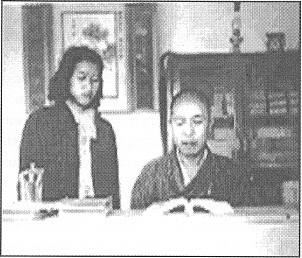 |
The author, still a child, standing next to the Ven. Master at Cixing Monastery. 作者年幼時,與上人在慈興寺合攝 |
從小到大,我就愛聽師父(宣公上人)講他年輕在家鄉時的那些故事。在香港這個西式大都會裡出生長大的我,一直猜測師父的家鄉雙城縣是什麼樣子?當地的孩子窮得沒鞋可穿、無玩具可玩,一些人還仍然住著茅屋,那究竟是什麼樣子的地方?
在今年三月底的一個晴日裡,我終於看到夢寐以見的師父家鄉了!
當我們步出哈爾濱機場,寒風料峭,已經讓大家打顫顫,尤其大夥才剛來自氣候溫暖的雲南;哈爾濱當天的氣溫是攝氏二、三度,不過在這個季節,這已經算是溫暖的了。我給大家打氣說:「師父真照顧我們!有這麼暖和的天氣,既不下雪,也無風暴!」
籠罩著我的一股暖流,勾起了我的思緒:年輕時,我和幾個同齡小孩一起在山上的「慈興寺」打禪七;清晨四點的寒氣,與此時難分軒輊。因為那兒沒有暖氣,師父總是會確定我們「衣服穿得夠暖和嗎?晚上被子夠厚嗎?」他的關心與慈愛,正如父親之於子女,深深烙在我們心裡。就在我們轉往北京一日後,一場暴風雪襲擊了哈爾濱;這純粹是運氣,還是因為師父在照顧我們?
在師父幼年時,雙城是屬於吉林省的小縣,五常也是附近的另一個小縣;時至今日,雙城和五常都變為大城市,屬黑龍江省。師父住的鑲白旗屯,現在屬五常市境,不再屬雙城市了;師父的村子,現在屬拉林鎮內(以前師父是當地「道德會」的負責人),這變化多大!自從上世紀40年代末期至今,中國人口已翻三倍!尤其近十年來,中國的經濟發展迅速,黑龍江省境擴大,現在擁有更多城鎮了。
由哈爾濱市到五常市的拉林鎮,開車只需二小時。途經昔日三緣寺所在的平房區,如今只見一片平地。此地有個紀念堂,據說是為憑弔在二次大戰時受害者,當時大部份的村民成為日軍細菌戰的實驗犧牲品,在短時間內一齊遭殺害。人生是多麼的無常呢!師父常常提醒我們要趁早修行:「當勤精進,如救頭然;但念無常,慎勿放逸」;「一失人身,萬劫難復」。這些偈頌,多麼真實不虛!
師父的姪孫白明志在收費站接我們,前往他住的民衛村(離師父幼年所住的村子約三、四英里處,但當地已不再有村子或房子了)。在民衛村,至今還有人住在茅屋裡!看得出來,有些村民還是工作辛苦、勉強糊口。村民多半種麥維生,因為天氣嚴寒,還沒有農事可做。
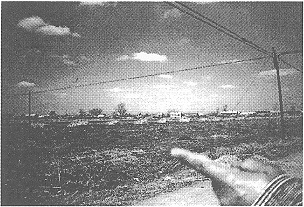 |
The finger is pointing to where the gravesite of Shifu’s mother used to be. 箭頭所指為昔日上人母墳所在地 |
我們也往訪上人母親的墳,它在兩條綿長的泥巴路交界之遠處。上人的出生地,鑲白旗屯是在此南邊約二、三英里處;不過現在也全鏟平作農地用了,所以其母的墳也已難再尋見了。
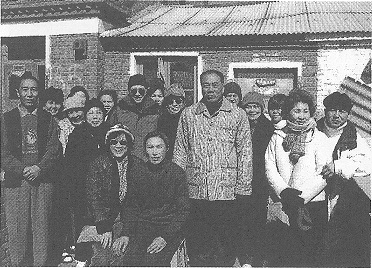 |
(左)團體合影於白明志宅前
(left) Group photo in front of Bai Mingzhi’s home. |
看今日師父的家鄉,再與75年前相比,我不難想像當時村民的貧窮,以及師父所經過的艱難困窘!我很慚愧,自己擁有如此好的環境和機緣,來跟隨這麼德高望重的師父學佛法,卻沒有更精進!
我現在才明白,師父為什麼總是告訴我們:「吃得苦中苦,方為人上人。」他也說:「富貴修道難。」難怪所至各處,師父都被如此地尊崇;因為他不但在東北,也在香港和美國,都忍受過這麼多艱辛與困苦。
在哈爾濱旅館內,渡過溫暖舒適的一夜,次晨,我們參訪東北四大廟宇之一的「極樂寺」。首座和尚知道我們來自美國,又是上人弟子,表示熱忱的歡迎;他未曾聽過常仁或常智大師,但知道上人是孝子,東北人也都以上人是東北同鄉為榮。首座和尚說:「在東北,上宣下化老和尚是當代唯一高僧;我們東北人,都分享這份光榮,並為他感到驕傲!」在中國南部的福州和廣州,我們也從遇到的其他東北人那兒,聽到同樣的稱讚。
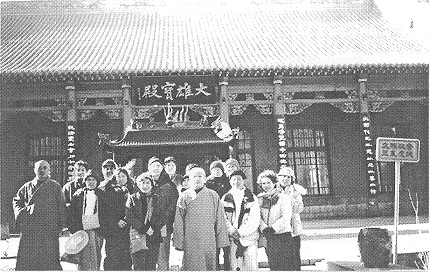 |
Group photo in front of Jile Monastery 團體攝於極樂寺前 |
「極樂寺」在文革期間嚴受重損,不過後來重建過;寺內僅存無損的,是一對唐宋時期的石獅。雖然師父肉身已離開我們十年,但近至美國,遠至東北,他的精神、他的慈悲、他的教化、他的微笑和他的尊貴,卻一直活在每個人的心中,永不磨滅。
很高興我有這趟參訪。旅程中,也走訪其他上人到過的地方,例如由中國剛到香港時住的「觀音洞」、「佛教講堂」、「慈興寺」,及其曾協助虛老的廣東「南華寺」、雲南的「大迦葉堂」,所到之處──即使是遠至東北,我們處處感受到上人的存在;但是對我而言,能親自見到他的家鄉,仍是旅程中最精彩的部份!誠願眾生但受諸樂,無有眾苦!
|
|
When I was young and growing up, I loved to hear Shi Fu (Venerable Master Hsuan Hua) telling me all of his youth stories that occurred in his hometown in Dongbei (northeast China). Being born and raised in the Westernized metropolitan Hong Kong, I always wondered what Shi Fu’s hometown, Shuangcheng (Twin Cities), looked like and what kind of place it was, where children didn’t even have shoes to wear or toys to play with and where some people still lived in thatched huts!
On one sunny day in late March this year (2005), I finally got to see Shi Fu’s hometown that I had always dreamed about!
As we got out of the plane at the Harbin Airport, we shivered in the chilly wind, especially since we had just come from the warm climate of Yunnan. The temperature was only 2-3 degrees Centigrade in Harbin that day, considered warm for that time of the year. “Shi Fu really takes care of us with such warm weather and there is neither snow nor storms!” I said to encourage everyone.
The warmth that went through me brought back memories of attending Chan sessions up in the mountains at Cixing Monastery (Hong Kong) when I was young, with a couple youngsters of my age. The chilly feeling up there in the early morning at 4 a.m. was not much different. Shi Fu would always ask us, “Are you dressed warmly enough? Do you have enough blankets at night?” since there was no heat up there. His caring heart and fatherly kindness has touched every one of us deeply. A snowstorm hit Harbin hard a day after we left for Beijing. Was this plain luck or because Shi Fu was looking after us!?
In Shi Fu’s childhood years, Shuangcheng was a small town in Jilin Province. Wuchang (Five Constant) was just another small town nearby Shuangcheng. Nowadays, Shuangcheng and Wuchang are both big cities in Heilongjiang Province. However, the village of Xiangbaiqi where Shi Fu lived is now in Wuchang, no longer in Shuangcheng. Also, Shi Fu’s birth village is now within the township of Lalin (where Shi Fu used to be the leader of the local Virtue Society). What a big change! Since the late 1940s, the population of China has tripled, especially in the last decade, as the economy of China has rapidly grown. The expanded Heilongjiang Province now covers many more cities and towns.
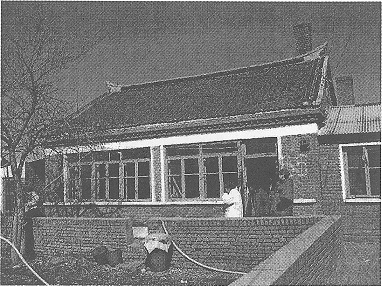 |
A house in Dongbei 東北的民房 |
It takes only a couple of hours by bus to get from Harbin to Lalin Town in Wuchang City. On the way, we passed by Pingfang District where Sanyuan (Three Conditions) Monastery had been located before. All you can see now is leveled land. There is a Memorial Hall to commemorate the World War II victims of the Japanese biological warfare in China, which wiped out almost every villager in a very short time. How true are the verses Shr Fu used to constantly say to us, to urge us to cultivate when we were young: “Be diligent and vigorous, as if your own head were at stake. Be mindful of impermanence and never be lax.” “Once you lose the human body, you may not get it back for 10,000 eons.”
We were greeted by Shi Fu’s grand nephew Bai Mingzhi at the toll gate and he led us to Minwei village where he lives (approximately 3-4 Chinese miles from Shi Fu’s village during his childhood, which no longer exists). In Minwei village, there are still people living in thatched huts! You can tell that some are still working hard, struggling to make a living. Most people in the village are farmers who rely on wheat farming. Because the weather was still very cold, they had no farm work to do yet.
We also went to the gravesite of Shi Fu’s mother at the far end of an intersection of two dirt roads. Shi Fu’s birthplace, Xiangbaiqi village, is about 2-3 miles to the south of that site. However, this area is all leveled to be farmland, hence the grave can no longer be found.
Comparing Shi Fu’s hometown now with that of 75 years ago, I can imagine how poor the villagers were then; and what kind of hardship and suffering Shi Fu went through! I am really ashamed that I did not cultivate more vigorously with all the best environments and opportunities I have to study Dharma from such a wonderful Master! How shameful!
Now, I understand why Shi Fu always told us that “if one can bear the most unbearable hardship, one can become the most outstanding heroic person”. He also said, “It is hard for the rich people to cultivate the Way.” No wonder Shi Fu was held in such high regard—venerated and respected everywhere he went, because he had endured so much hardship—not just in Dongbei, but also in Hong Kong and in America.
After spending a warm and comfortable night at a Harbin hotel, we visited Jile (Ultimate Bliss) Monastery(one of the four biggest monasteries in Dongbei) the next morning. The head monk there welcomed us cordially after finding out that we were from America and were disciples of the Ven. Master, but he had not the slightest idea about Venerable Masters Chang Ren and Chang Zhi. He did know that Shi Fu was one of the Filial Sons. He told us that Dongbei people take great pride in Venerable Master Hua’s origin. “In Dongbei, ‘Hsuan Hua Lao-he-shang’ (Venerable Master Hsuan Hua) is the only high monk of last century. We, being from the Northeast China, also share the honor and feel proud.” We also heard the same praise from other Dongbei people whom we encountered in Fuzhou and Guangzhou in the southern China.
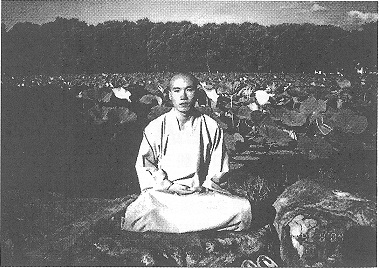 |
(右)白明志之子,上人的曾姪孫,法號正湛
(right) Dharma Master Zheng Zhan, youngest son of Bai Mingzhi, great grand nephew of Shi Fu |
Jile Monastery was severely damaged during the Cultural Revolution, but was rebuilt afterwards. The only object intact was a pair of sculptured stone lions, which dated back to the Tang or Song Dynasty.
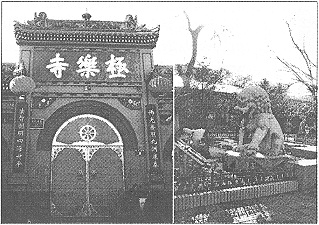 |
|
The front gate and a stone lion at Jile Monastery
極樂寺的山門與石獅 |
Although Shi Fu’s physical body has left us for ten years, his spirit, kindness, teachings, smile and his nobleness lives on in everyone’s heart and can never be destroyed.
I am very glad that I made this trip. We also visited some other places that Shi Fu had been to before, such as the Guanyin Cave, where he first came to Hong Kong, the Buddhist Lecture Hall, Cixing Monastery; Nanhua Monastery in Guangzhou where he helped Venerable Master Xu Yun, and the Mahakasypa Hall in Yunnan; in all these places, even as far as Dongbei, we can feel Shi Fu’s spirit. As for me, to be able to see his hometown personally is still the best of all!
May all beings have no suffering but only enjoy happiness!
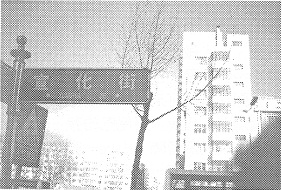 |
A street outside Jile Monastery called “Hsuan Hua”
極樂寺外的宣化街 |
|